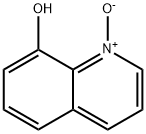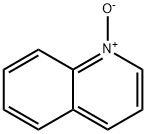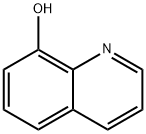8-Hydroxyquinoline-N-oxide
Synonym(s):8-Hydroxyquinoline N-oxide
- CAS NO.:1127-45-3
- Empirical Formula: C9H7NO2
- Molecular Weight: 161.16
- MDL number: MFCD00006739
- EINECS: 214-430-3
- SAFETY DATA SHEET (SDS)
- Update Date: 2025-07-24 18:12:16

What is 8-Hydroxyquinoline-N-oxide?
Description
A quinoline derivative that displays mutagenic activity. It suppresses luminescence of an indicator bacterium that is named Photobacterium phosphoreum. This chemical forms two kinds of complexes with palladium (II) and Gold (III). One kind is an ion-associated compound containing hydrogen bond and hte other is the six membered metal chelates containing metal-oxygen bonds.
Chemical properties
Yellow Crystalline Solid
The Uses of 8-Hydroxyquinoline-N-oxide
A quinoline derivative; shows mutagenic activity.
What are the applications of Application
8-Hydroxyquinoline N-Oxide is A quinoline derivative that displays mutagenic activity
Definition
ChEBI: 8-hydroxyquinoline N-oxide is a quinoline N-oxide carrying a hydroxy substituent at position 8. It is a monohydroxyquinoline and a quinoline N-oxide. It is functionally related to a quinolin-8-ol. It is a conjugate acid of an 8-hydroxyquinoline N-oxide(1-).
General Description
8-Quinolinol N-oxide is a toxicant which can suppress luminescence of an indicator bacterium Photobacterium phosphoreum. It forms two types of complexes with gold(III) and palladium(II): type I are ion-associated compounds containing hydrogen bond and the other is the six-membered metal chelates containing metal-oxygen bonds.
Synthesis
8-hydroxyquinoline-N-oxide was synthesized from 8-hydroxyquinoline. A stirred solution of 8-hydroxyquinoline (25.00 g, 172.2 mmol) in 550 ml of CHCl3 was cooled to 0° C., and 3 -chloroperoxybenzoic acid (40.00 g, 80% Tech. grade *0.231 mmol=0.185 mmol) was added slowly over 3 minutes. The solution was kept at 0° C. and stirred for 3 hours. During this period, the 3-chlorobenzoic acid byproduct precipitated. The 3-chlorobenzoic acid was removed by filtration and the orange filtrate was concentrated to dryness and the remaining solid was triturated with 2% NH40 H (2*200 ml). The solid was isolated on a frit and washed with H2O.
Properties of 8-Hydroxyquinoline-N-oxide
| Melting point: | 135-138 °C (lit.) |
| Boiling point: | 267 °C(lit.) |
| Density | 1.2480 (rough estimate) |
| refractive index | 1.5050 (estimate) |
| Flash point: | 139 °C |
| storage temp. | Inert atmosphere,2-8°C |
| solubility | Soluble in Acetone, Chloroform, Dichloromethane, Ethyl Acetate and Methanol |
| form | Solid |
| pka | 6.03±0.30(Predicted) |
| color | Yellow |
| BRN | 128737 |
| CAS DataBase Reference | 1127-45-3(CAS DataBase Reference) |
Safety information for 8-Hydroxyquinoline-N-oxide
| Signal word | Warning |
| Pictogram(s) |
 Health Hazard GHS08 |
| GHS Hazard Statements |
H317:Sensitisation, Skin H372:Specific target organ toxicity, repeated exposure |
| Precautionary Statement Codes |
P201:Obtain special instructions before use. P202:Do not handle until all safety precautions have been read and understood. P260:Do not breathe dust/fume/gas/mist/vapours/spray. P270:Do not eat, drink or smoke when using this product. P272:Contaminated work clothing should not be allowed out of the workplace. P363:Wash contaminated clothing before reuse. P302+P352:IF ON SKIN: wash with plenty of soap and water. P308+P313:IF exposed or concerned: Get medical advice/attention. P403:Store in a well-ventilated place. |
Computed Descriptors for 8-Hydroxyquinoline-N-oxide
New Products
Indole Methyl Resin tert-butyl 9-methoxy-3-azaspiro[5.5]undecane-3-carboxylate Boc-His(Boc)-OH 2-CTC Resin 4-Chloro-7-tosy1-7Hpyrrolo[2,3-d]pyrimidine 5,7-Dibromo-1H-indole 2,5-dichloro-N-hydroxy-4,6-dimethylpyridine-3-carboximidamide 2,2-Dimethoxy-7-azaspiro[3.5]nonane hydrochloride 4-chloromethyl-5-methyl-1,3-dioxol-2-one (DMDO-Cl) R-2-BENZYLOXY PROPIONIC ACID 1,1’-CARBONYLDIIMIDAZOLE 1,1’-CARBONYLDI (1,2-4 TRIAZOLE) N-METHYL INDAZOLE-3-CARBOXYLIC ACID 4-((2-hydroxyethyl)thio)benzoic acid 1-(TERT-BUTOXYCARBONYL)-2-PYRROLIDINONE Methyl 6-methylnicotinate 3-Pyridineacrylic acid tert-Butyl carbazate TETRAHYDRO-2H-PYRAN-3-OL 2-((4-morpholinophenylamino) (methylthio) methylene) malononitrile 3-(4-morpholinophenylamino)-5-amino-1H-pyrazole-4-carbonitrile 2,4-dihydroxybenzaldehyde 1,3-Diethyl-1,3-Diphenylurea Methyl 2-methylquinoline-6-carboxylateRelated products of tetrahydrofuran








You may like
-
 8-Hydroxyquinoline N-Oxide CAS 1127-45-3View Details
8-Hydroxyquinoline N-Oxide CAS 1127-45-3View Details
1127-45-3 -
 8-Quinolinol N-oxide CAS 1127-45-3View Details
8-Quinolinol N-oxide CAS 1127-45-3View Details
1127-45-3 -
 Pyridine 99.5% HPLC /UV SpectroscopyView Details
Pyridine 99.5% HPLC /UV SpectroscopyView Details
110-86-1 -
 Piperazine Spot supply, best priceView Details
Piperazine Spot supply, best priceView Details
110-85-0 -
 Dibutyl PhthalateView Details
Dibutyl PhthalateView Details
84-74-2 -
 Imidazole Spot supply, competitive priceView Details
Imidazole Spot supply, competitive priceView Details
288-32-4 -
 Octadecyl 3-(3,5-di-tert-butyl-4-hydroxyphenyl)propionate 98% (GC)View Details
Octadecyl 3-(3,5-di-tert-butyl-4-hydroxyphenyl)propionate 98% (GC)View Details
2082-79-3 -
 Thiourea 99% ARView Details
Thiourea 99% ARView Details
62-56-6
